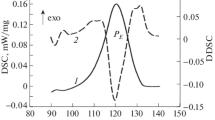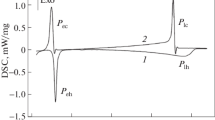Abstract
High-resolution differential scanning calorimetry has been used to study the crystallization of binary alloys with unlimited and limited solubility of their constituents. A sharp and intense emission of crystallization heat has been invariably observed immediately below the liquidus curve. Standard techniques to describe crystallization in the intercritical temperature range cannot explain the above phenomena. It is assumed that they may be associated with a large number of local microvolumes enriched with a crystallization-controlling component (concentration fluctuations) that appear in the liquid as approaching the liquidus curve. The appearance of such microvolumes precedes the spontaneous formation of many crystallites in a large volume of the liquid phase.








Similar content being viewed by others
REFERENCES
Ya. S. Umanskii, B. I. Finkel’shtein, and M. E. Blanter, Physical Metallography (Metallurgizdat, Moscow, 1958).
Ya. S. Umanskii and Yu. A. Skakov, Metal Physics (Atomizdat, Moscow, 1978).
H. Biloni and W. J. Boetinger, in Physical Metallurgy, 4th ed., Ed. by R. W. Cahn and P. Haasen (North-Holland, Amsterdam, 1996), p. 669.
M. E. Glicksman, Principles of Solidification: An Introduction to Modern Casting and Crystal Growth Concepts (Springer, New York, 2011).
W. Kurz and D. J. Fisher, Fundamentals of Solidification, 4th ed. (Trans Tech, 1998).
N. S. Kurnakov, Introduction to Physicochemical Analysis, 4th ed. (Akad. Nauk SSSR, Moscow, Leningrad, 1940).
B. Cantor, J. Therm. Anal. 42, 647 (1994).
L. Heusler and W. Schneider, J. Light Metals 2, 17 (2002).
J. Piatkowski, V. Przeliorz, and V. Szymszal, Arch. Foundry Eng. 17, 207 (2017).
J. Piatkowski and B. Gajdzik, Metalurgija 52, 469 (2013).
A. V. Skripov and V. P. Skripov, Sov. Phys. Usp. 22, 389 (1979).
E. S. Venttsel’ and L. A. Ovcharov, Probability Theory and Its Engineering Applications, 2nd ed. (Vysshaya Shkola, Moscow, 2000).
L. V. Spivak and N. E. Shepina, Fundam. Probl. Sovrem. Materialoved. 11, 376 (2014).
Author information
Authors and Affiliations
Corresponding authors
Ethics declarations
The authors claim that there are no conflicts of interest.
Additional information
Translated by V. Isaakyan
Rights and permissions
About this article
Cite this article
Spivak, L.V., Shchepina, N.E. Thermal Effects Due to Crystallization of Alloys with Unlimited and Limited Solubility of Components. Tech. Phys. 64, 1319–1323 (2019). https://doi.org/10.1134/S1063784219090184
Received:
Revised:
Accepted:
Published:
Issue Date:
DOI: https://doi.org/10.1134/S1063784219090184




